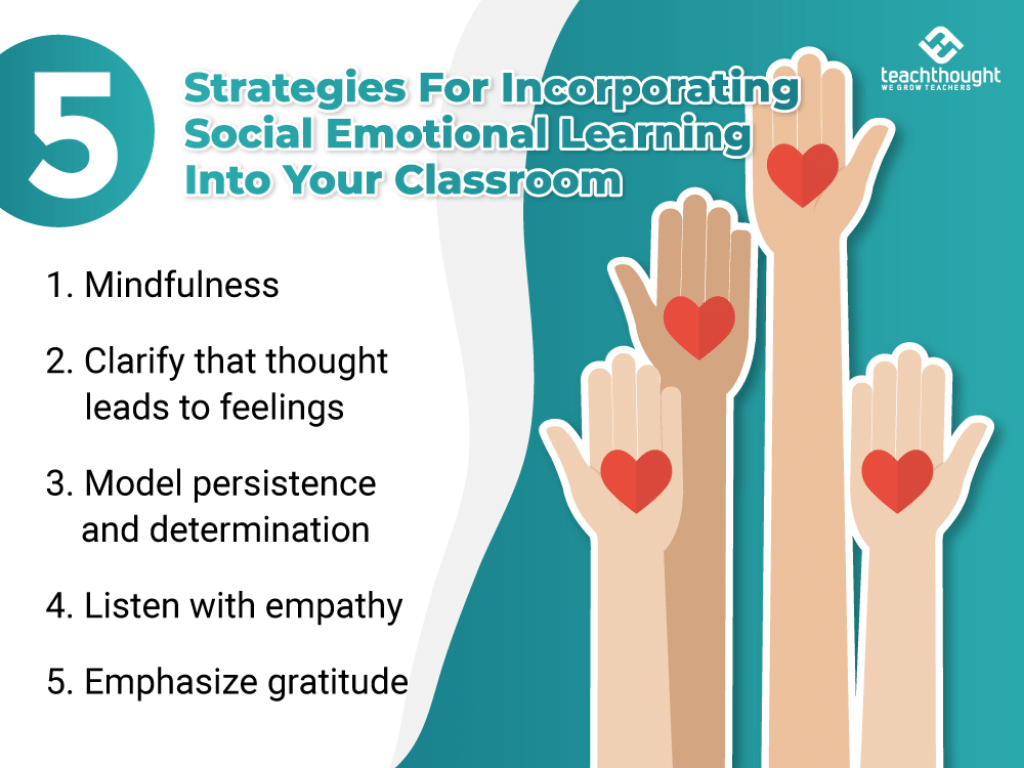

contributed by Meg Price, the ei experience
Social-emotional learning (SEL) by definition is a process for learning life skills, including how to deal with oneself, others, and relationships, and work in an effective manner.
Although there are many great SEL programs, SEL can also be incorporated into each lesson as a way of teaching students to understand how to action the skills in a variety of situations and form positive habits. All students start school with some level of social and emotional skills, and all will develop their social and emotional skills at different rates.
Parents and teachers are both responsible for teaching students life skills, and certainly, much of what they learn will be by watching our actions. The five strategies below are will not only benefit students’ social-emotional learning, but can also be beneficial to teachers’ well-being, too.
See also The Benefits Of Social-Emotional Learning
5 Strategies For Incorporating Social-Emotional Learning Into Your Classroom
1. Through mindfulness
Mindfulness is: paying attention, in a particular way, on purpose, in the present moment, non-judgmentally.
We are hearing more and more about the benefits of mindfulness for children. Increased attention leads to better performance academically and increased emotional and social intelligence. Children are better able to learn, nurture themselves, and be aware of their own emotional needs.
Mindfulness practices help students focus on their breath, body, thoughts, feelings, and the world around them. When they can observe their thoughts and feelings, they have the freedom to choose how they will speak and act–which can lead to a happier, more harmonious classroom.
There are many mindfulness activities available for free–on YouTube, for example. Further, there are mindfulness and meditation apps that can provide frameworks for getting started. Why not start each lesson with a different mindfulness activity?
2. Clarify that thoughts lead to feelings
Research shows that students who are more resilient are more academically successful. Resilient students bounce back quicker, are mindful of their thinking, understand their beliefs, and, importantly are able to challenge their beliefs and thoughts to create more positive outcomes.
This is an important concept because we may not always be able to influence what happens to us, but we do have a powerful influence on how we interpret what happens to us and how we deal with it. Many students are unaware that their thoughts play a large role in influencing how they feel.
No matter what happens to you, nobody can take this away from you. It is an empowering lesson to teach whenever you hear a student express frustration, anger, and other negative emotions. As a teacher, you can help by listening for the emotion, then helping your student understand where that emotion came from and how to adjust their thinking in a way that contributes to their social-emotional well-being.
3. Model persistence and determination
A really important aspect of well-being and SEL is the ability to accomplish things in life. Many students naturally strive to better themselves in some way, whether they are seeking to master a skill, achieve a valuable goal, or win in some competitive event.
Other students need some coaching in this area. Teaching students each and every lesson that accomplishes things takes effort, patience, and perseverance are important. Praise for effort is critical in this area of SEL. Each student will need to be encouraged to set stretch goals during lessons to feel a sense of accomplishment.
By being mindful and challenging negative thoughts, students can be encouraged to dig deep to find the determination to succeed.
4. Listen with empathy
Put another way, listen to be surprised.
Part of SEL is an understanding of the importance of positive relationships. To have these relationships, we need to have and teach empathy. Teachers have a wonderful ability to model empathy. Encourage students to listen to others, then ask them to listen to be surprised and understand how other students might be feeling. What opportunities do you have each class to find ways for students to help each other and learn something new about other people’s ideas?
Use the opportunity in class to teach students to ask questions framed to encourage response, not encourage defensiveness. For example, when John says, “Sam, why can’t you just follow the instructions?” encourage John to re-frame his question for a better understanding of what Sam is seeking “Sam, can we work through these instructions together to ensure they make sense?
5. Emphasize gratitude
Once again, research is showing us that a really important aspect of well-being is gratitude. This research indicates those who regularly express gratitude have more energy and enthusiasm, less stress, and better physical well-being. There are some very simple ways to increase your experience and expression of gratitude; however, this may require that we train ourselves to think differently.
For students, this can be done by incorporating some simple exercises into each lesson. At the end of each class, ask students to reflect on the class using these three questions:
– What aspects of this class did you enjoy today?
– Who did you enjoy working with today?
– What areas of this topic would you like to learn more about?
Most importantly, above all have fun in each and every class; learning should be fun and play is a really important part of Social-Emotional Learning!
Source link




